As we noted a couple of issues ago, the shooting community is seeing more and more factory-supplied threaded barrels on rifles to allow application of muzzle devices, including sound suppressors. In that previous test of 308 Winchester and 300 Blackout bolt rifles, we noted generally better accuracy with the rifles when fitted the cans, but we didn’t cover how much more pleasant the centerfire rifles were to shoot. Our shooters noted a marked difference in recoil at the shoulder, and, perhaps more profound, the lack of muzzle blast and report created better shooter conditions behind the gun. A lot of things can contribute to flinching and missing, and noise and a sharp push into the shoulder are two of them.
This time, we cut way down on the noise — to practically nothing, which has its own appeal — by shooting three rimfire bolt-actions side by side with a suppressor. We realize one of the drawbacks of shooting quieter is the initial cost of the cans as well as the red tape. We can’t do much about the red tape other than to say get yourself an NFA trust, depending on where you live. But we can offer a strategy for making the can work across many firearms, so you can amortize its cost per shot. But first, the rifles.

We ordered all three rimfires online from BudsGunShop.com. The rifles, a Ruger American Rimfire, a CZ-USA 455, and a Savage MKII FV-SR, were delivered in less than a week to 2nd Amendment Arms and Ammo in Katy, Texas (2ndaaa.com, [281] 475-3160), a preferred Bud’s FFL who charges only a $10 transfer fee per gun with a Texas License to Carry and $20 per gun without the TLC.)
Our first test rifle was a Ruger American Rimfire Standard 8305 22 LR, $309. Ruger’s American Rimfire line is already extensive, and new models will build it out further. The 8301 is similar to our test 8305 model, with the former having a barrel length of 22 inches rather than the 18-incher on our rifle. Other 22 LR chamberings in the line include the 8351, which has an 18-inch stainless tube; the Talo Distributor Exclusive 8331, which comes with a Muddy Girl Camo Synthetic stock; and The Shooting Store Distributor Exclusive Model 8334, which has an OD green synthetic stock that contrasts with the black comb modules. Other chamberings include 17 HMR (Model 8311 with a 22-inch barrel; Model 8312 with an 18-inch barrel) and 22 WMR (Models 8321 and 8322, with 22- and 18-inch barrel lengths, respectively).

Our second rifle was the CZ-USA 455 American Synthetic Suppressor-Ready 02114 22 LR, $373. Like the Ruger, the CZ 455 02114 is part of a sizable line of rimfires offered by the Kansas City, Kansas-based importer. Among the other offerings in the 455 line are the CZ 455 American Combo Package, which comes in 22 LR and also ships with a 17 HMR barrel, along with everything you need to make the caliber change. Other interesting models include the 455 American Stainless, which comes with a swappable 20.5-inch barrel finished in a matte bead blast. For those of you who don’t foresee ever buying a suppressor, the American Synthetic is similar to our test gun but is not suppressor-ready. The price difference is so small, $421 for the threaded rifle and $385 for the non-threaded barrel, we don’t see the value in the threadless version.
The third rifle was the Savage Arms MKII FV-SR Threaded Barrel 28702 22 LR, $248. The shooter may wonder if the $248 price suggests that this rifle is cheap. It is inexpensive, but not cheap. One example of value was the receiver-mounted Picatinny top rail, which allowed us to pop on a Nikon scope with ease and bore-sight the rifle in minutes. Very handy. Also, there’s the adjustable AccuTrigger, which came out of the box at 2.4 pounds.

The Savage presents as a much bigger product than the others, mainly because of the heavy target, free-floating, button-rifled barrel. The tubes on the others tend more toward Sporter contours, as the dimensions at the muzzles suggest (0.870 inch for the Savage and 0.613 inch for the CZ and 0.635 inch for the Ruger). Range weights were close as well, with the Savage at 7.25 pounds, the CZ at 7.0 pounds, and 7.1 pounds for the Ruger. As such, any of these three would be totable for a day of squirrel or rabbit hunting, even with a suppressor. The Savage’s black synthetic stock is a drawback, to our eyes, because it doesn’t have enough height for the shooter to rest his face on.
We fired most of our bench rounds with the cheek off the stock because pushing down onto it wasn’t comfortable with the tall rings we used (which provide a more erect head position). For long-term use as is, the shooter would need shorter rings or a strap-on cheekpiece pad, or a different stock. Obviously, the first two options are more affordable. We would also have liked more capacity for both the Savage and the CZ, which came with 5-round stick magazines compared to the rotary Ruger’s 10-round magazine. Also, for all three, we would have liked at least one extra mag to have come with the rifle. If you decide to buy one of these rifles, plan to buy three to five more magazines at the outset. Also, we believe the CZ and the Savage have a small disadvantage in that the magazines aren’t flush-fit like the Ruger’s. The five-rounders didn’t stick out the bottoms of the first two rifles much, but they were noticeable when shooting standing with a competition-style support arm resting on the chest and the support hand under the magwells on the CZ and Savage.
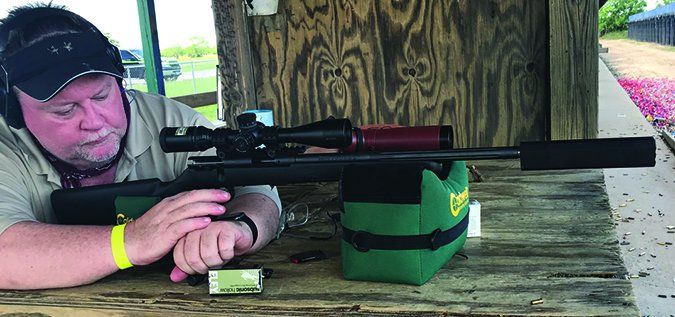
How We Tested
To collect chronograph and accuracy data, we set up at American Shooting Centers in Houston (AMShootCenters.com). We recorded velocities using an Oehler Model 35 Proof Chronograph ($595 from Oehler-Research.com) with the first screen set 10 feet from the muzzle. Velocities were recorded with an air temperature of 90 degrees and 90% humidity, with 20-mph 6 o’clock winds. For bench-accuracy shooting at 50 yards, we fired the rifles off Caldwell DeadShot shooting bags. Accuracy is the average group size for five five-shot groups, measured center-to-center of the widest-apart bullet holes in each group, then rounded to the nearest tenth of an inch. Suppressed data was collected with a SilencerCo Osprey 45 ($756 at SilencerShop.com) directly after we shot the unsuppressed data for each round.
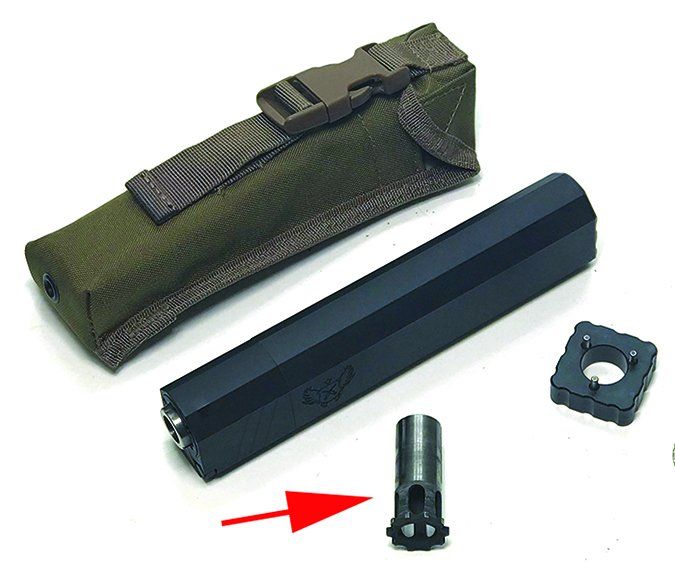
The riflescope for the Savage was a Nikon M-223 series 3-12x42mm No. 16305. The scope is equipped with a side-focus turret for parallax correction and a one-piece 1-inch main tube that is nitrogen-filled and O-ring-sealed. The glass lens elements are fully multi-coated and offer sharp target images. Adjustment clicks gave the expected eighth-inch bullet impact movement at 50 yards, and we could adjust the click-stops while keeping the head on the stock because the adjustments have tactile clicks. Eye relief was 3.9 inches. It costs $460 at OpticsPlanet.com. We mounted the scope to the Savage’s Picatinny top rail with Weaver’s Six Hole Tactical Rings.
To get things going on the Ruger and the CZ, we mounted a 30mm Leupold VX-R 3-9x40mm Matte FireDot Duplex scope (Leupold #110686, $500 at OpticsPlanet.com) on them. The FireDot scope has an illuminated dot right in the center of the duplex reticle. Its intensity can be stepped down by a switch on the left side of the scope — a useful setup for low-light conditions. An illuminated reticle in full sunlight doesn’t make sense until you shoot the VX-R with the fiber-optic FireDot reticle. The bright dot allowed us to center on the target X-rings for precise shot placement. The proprietary MST (Motion Sensor Technology) automatically deactivates illumination after 5 minutes of inactivity, yet reactivates instantly as soon as any movement is detected. The 1/4-minute-of-angle precision finger click adjustments for windage and elevation were helpful in getting each round zeroed because the different bullet weights changed elevation and were susceptible to wind effects.
We used high matte-blued-steel Warne 30mm 22-caliber rings (about $40 at MidwayUSA.com), which have an asymmetrical reversible side clamp to fit a 3⁄8-inch or 11mm dovetails, with the Ruger having the former and the CZ having the latter. This horizontally split design securely mounted to our firearms with Torx-style T-15 socket cap screws, which we torqued to 25 in./lbs. of force. The solid asymmetrical reversible clamp can be flipped 180 degrees and used on wider or narrower dovetails for the best fit. If we were going to use different optics on these rifles, we’d probably opt for Weaver’s T-22 Base Pair to convert grooved receivers to accept Weaver-style rings, allowing for a variety of scope mount configurations (WeaverOptics.com #48459 T-22 Base Pair, $13.45).
The Suppressor
What we’ve been attempting to do with silencers for a few years now is to pick a system that will work on the widest-diameter caliber that we usually shoot, the 45 ACP, then use that for all the sub-calibers we test. Reason: Suppressors are expensive and they are hard to transact, so we haven’t been able to get a dependable match up of the devices. So we decided to go big and live with what might be a slight lessening of the suppression when we drop to 40 S&W, 9mm, or in this case, 22 LR. For this test, we attached a SilencerCo Osprey 45 ($756 at SilencerShop.com), a distinctive pistol can that sports a monocore baffle design. It has an offset (or eccentric) appearance, which allows this polygonal suppressor to hold 30% more internal volume than a traditional round-tube silencer at the same length.
The SilencerCo Osprey 45 provides shooters a hearing-safe 131.3 dB output with 45 ACP ammo. With a black-oxide aluminum shell and stainless-steel internals, the Osprey 45 weighs 11.1 ounces and measures 8 inches in length. To fit our 22 rifles, which were threaded 1⁄2×28 TPI at the muzzle, we used a 9mm Osprey piston, $71, the current price at Silencer Shop in Austin. If we use this suppressor on other rifles or pistols, we simply have to buy the appropriate piston for that caliber and thread pattern. The Osprey comes with a tool to remove the piston and a user manual. To install the piston in the end attaching to the muzzle, the user slides the piston (a stainless cylinder with spokes on one end) into a spring inside a threaded adapter, which then screws into the suppressor body.

Installation on the rifles was simple: With the magazine out of the rifle and the bolt out of the action, we screwed off the thread protector, then tilted the rifle muzzle upward and started the Osprey onto the provided muzzle threads. We had no trouble attaching the suppressor to any of the rifles. We advise removing the bolt and magazine as absolute safety steps because the working hand gets in front of the muzzle when removing the thread protector and installing the can. We then screwed the Osprey down as far as it would go on the muzzle threads, aligned it with the top of the barrel, and tightened the locking collar. With the bolt out of the gun, we then checked to ensure there were no obstructions in the barrel.
We shot the Osprey and found the report to be very quiet with the supersonic rounds, and we heard practically no sound with the subsonic rounds. In fact, with the Eley Hollow subsonic round, we could hear through the stocks the mechanical sounds of the bolt parts moving during the shot, but not the report. That’s a very unusual sensation and one that’s easy to get used to in short order.
Range Data
CZ 455 American Synthetic Suppressor-Ready:
| 22 LR Armscor 36-gr. HVHP 50015 | Unsuppressed | Suppressed |
| Average velocity | 1241 fps | 1281 fps |
| Muzzle energy | 123 ft.-lbs. | 131 ft.-lbs. |
| Average group | 1.3 in. | 0.8 in. |
| 22 LR EleyHollow38-gr. Lead HP | ||
| Average velocity | 1000 fps | 1022 fps |
| Muzzle energy | 84 ft.-lbs. | 88 ft.-lbs. |
| Average group | 1 in. | 0.5 in. |
| 22 LRWinchester40-gr. Lead RN | ||
| Average velocity | 1187 fps | 1200 fps |
| Muzzle energy | 125 ft.-lbs. | 128 ft.-lbs. |
| Average group | 1.1 in. | 0.8 in. |
Ruger American Rimfire Standard:
| 22 LR Armscor 36-gr. HVHP 50015 | Unsuppressed | Suppressed |
| Average velocity | 1271 fps | 1272 fps |
| Muzzle energy | 129 ft.-lbs. | 129 ft.-lbs. |
| Average group | 1.1 in. | 1 in. |
| 22 LR EleyHollow38-gr. Lead HP | ||
| Average velocity | 1046 fps | 1058 fps |
| Muzzle energy | 92 ft.-lbs. | 94 ft.-lbs. |
| Average group | 1 in. | 0.9 in. |
| 22 LRWinchester40-gr. Lead RN | ||
| Average velocity | 1195 fps | 1189 fps |
| Muzzle energy | 127 ft.-lbs. | 126 ft.-lbs. |
| Average group | 1.1 in. | 1.1 in. |
Savage Arms MKII FV-SR Threaded Barrel:
| 22 LR Armscor 36-gr. HVHP 50015 | Unsuppressed | Suppressed |
| Average velocity | 1238 fps | 1261 fps |
| Muzzle energy | 122 ft.-lbs. | 127 ft.-lbs. |
| Average group | 1.1 in. | 1 in. |
| 22 LR EleyHollow38-gr. Lead HP | ||
| Average velocity | 1014 fps | 1025 fps |
| Muzzle energy | 87 ft.-lbs. | 89 ft.-lbs. |
| Average group | 0.7 in. | 0.5 in. |
| 22 LRWinchester40-gr. Lead RN | ||
| Average velocity | 1172 fps | 1179 fps |
| Muzzle energy | 122 ft.-lbs. | 123 ft.-lbs. |
| Average group | 1 in. | 0.9 in. |
Test Ammunition & Results
At sea level, the speed of sound is roughly 1125 fps. Subsonic ammo is easier to suppress at the muzzle, and it doesn’t create the downrange “crack” as the bullet breaks the sound barrier.
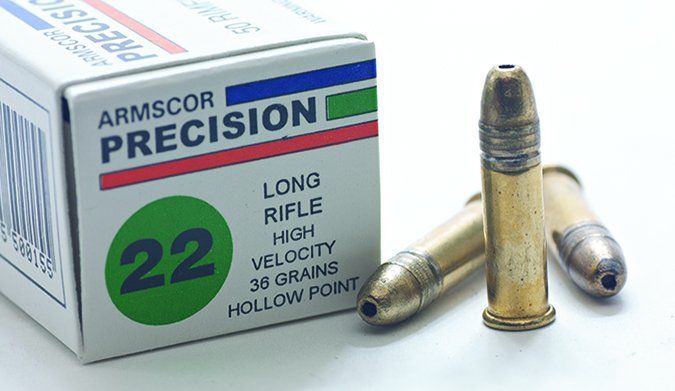
Our test 22 Long Rifle ammunition included Armscor 36-grain High-Velocity Hollow Point 50015 ($2.16/50 from BudsGunShop.com); Eley Subsonic 05400 38-grain Lead Hollow Point ($7.36/50 from BudsGunShop.com); and Winchester M-22 40-grain Black Copper-Plated Lead Roundnose WINS22LRT ($48.49/1000 from BudsGunShop.com).
As shown in the nearby Range Data tables, the Savage shot the best groups, near 1-minute-of-angle, with the Eley subsonic hollowpoints. Average group sizes were 0.7 inches unsuppressed and 0.5 inches suppressed. Notably, the CZ also shot the Eley into 0.5-inch groups suppressed. The average group sizes for the CZ/Eley combo were 1.0 inches unsuppressed and in the Ruger, 1.0 inches unsuppressed and 0.9 inches suppressed.
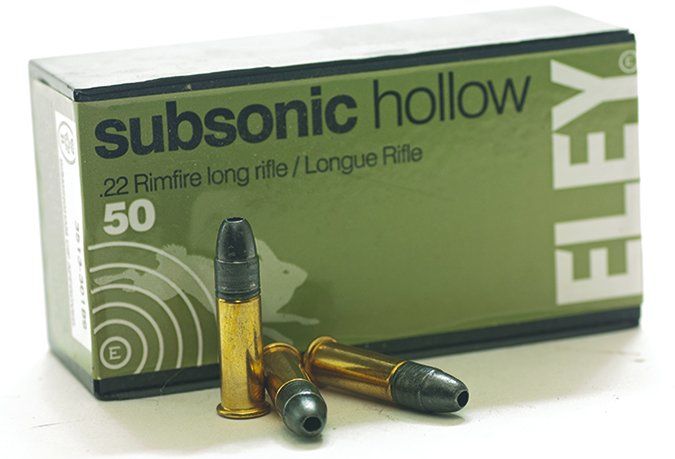
Accuracy wasn’t as good with the Armscor 36-grain High-Velocity Hollow Points. The best group average with this ammo came in the suppressed CZ, 0.8 inches. But its unsuppressed average was 1.3 inches. In the Savage and Ruger, that ammo shot 1.1-inch average groups unsuppressed and 1.0-inch groups suppressed. The heavier but still supersonic Winchester M-22 40-grain lead roundnose rounds shot unsuppressed average groups of 1.0 inches and suppressed average groups of 0.9 inches in the Savage, very close to the CZ’s 1.1 and 0.8 readings, followed by the Ruger at 1.1 inches unsuppressed and suppressed.
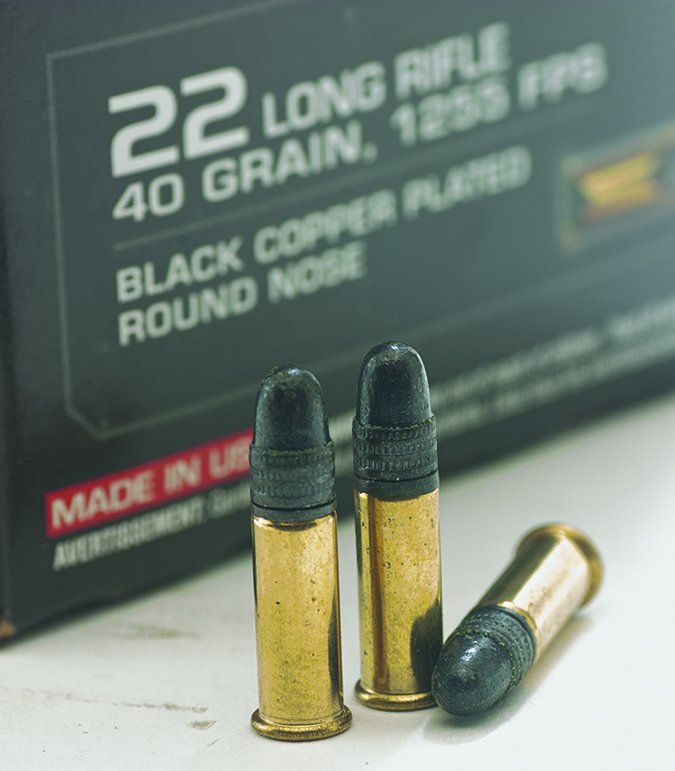
Velocities are important to gauge how near each round was to going subsonic. The Eley, of course, had all velocities below supersonic, at 1000 fps unsuppressed and 1022 fps suppressed in the CZ, 1046 fps and 1058 fps unsuppressed/suppressed in the Ruger, and 1014 fps and 1025 fps unsuppressed/suppressed in the Savage. It’s interesting to note that in all three rifles, the suppressed readings were higher. That trend held with the other ammos as well, with the Armscor’s velocities being 1241 fps/1281 fps unsuppressed/suppressed in the CZ; 1271 fps/1272 fps unsuppressed/suppressed in the Ruger; and 1238 fps/1261 fps unsuppressed/suppressed in the Savage Mark II.
Here are more detailed notes about how each rifle performed individually.
Savage Arms MKII FV-SR Threaded Barrel 28702 22 LR, $248
GUN TESTS GRADE: A-
Affordable and a great shooter. Shot lights out with the Eley subsonic load, which would make it a great varmint or small-game rifle when silence is golden.

| ACTION | Bolt; steel cylindrical receiver |
| OVERALL LENGTH | 34.75 in. |
| HEIGHT UNBOXED | 7 in. |
| HEIGHT AS TESTED | 9.75 in. |
| MAX WIDTH | 3.25 in. |
| WEIGHT UNBOXED | 6 lbs. |
| WEIGHT AT RANGE | 7.25 lbs. |
| BARREL LENGTH/TWIST | 16.5 in.; 1:16 RH |
| BARREL FINISH/MATERIAL | Matte-blue carbon steel button rifled, fluted, target |
| BARREL FREE-FLOATED | Yes |
| BARREL MUZZLE DIAMETER | 0.870 in. |
| MUZZLE STYLE/DEVICE | 1/2″-28 thread; checkered steel thread protector |
| STOCK | Black synthetic; checkered pistol grip & forend |
| STOCK LENGTH OF PULL | 13.5 in. |
| STOCK COMB STYLE | Straight |
| DROP AT COMB | 1.5 in. |
| DROP AT HEEL | 2 in. |
| STOCK CAST | None |
| STOCK HANDEDNESS | Ambidextrous |
| FOREND STYLE | Sporter; plain |
| BUTTPAD THICKNESS | 0.3 in.; contoured black plastic |
| SLING SWIVEL STUDS | 1 butt, 1 forend |
| STOCK GRIP CAP | Black plastic |
| TRIGGER PULL WEIGHT | 2.4 lbs.; AccuTrigger; adjustable |
| TRIGGER STYLE | Single stage |
| TRIGGER GUARD MATERIAL | Black composite, integral |
| SAFETY | 2-position slider button |
| MAGAZINE | (1) 5-rd. single stack |
| MAGAZINE RELEASE | Grooved steel tab; rear of magazine |
| BOLT | Blued steel; two extractors; 60-degree throw, one-piece bolt handle |
| BOLT RELEASE | Trigger |
| SIGHTS | None |
| OPTICS MOUNTING HARDWARE | Picatinny rail installed; aluminum |
| WARRANTY | 1-year limited |
| TELEPHONE | (800) 370-0708 |
| WEBSITE | SavageArms.com |
| MADE IN | Westfield, MA |
Obviously, if this gun shot, it would be the Best Buy of the test, coming in $125 below the CZ and $61 below the Ruger. This was further compounded by the Savage having a Pic rail already installed. You could argue that the Ruger was better equipped because it came with open sights, but for our uses, that didn’t matter to us. In the box came the rifle with the rail, a lock, and manual. The manual was for the Mark I, Mark II, Rascal, Model 93, B.Mag, Models 300, 305, and 310.
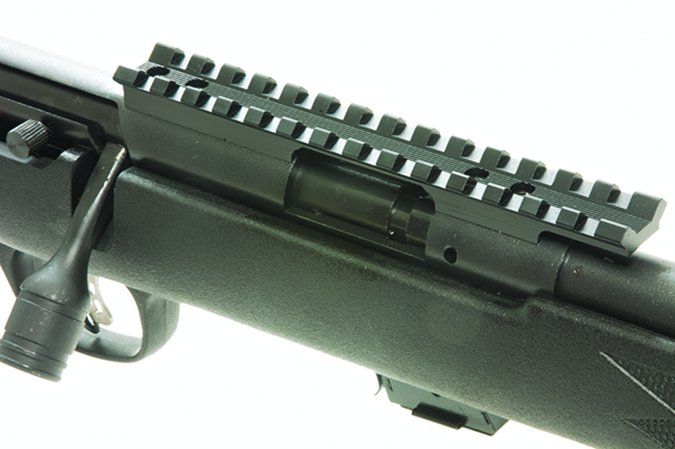
This looks like a big rifle, despite its short barrel length of 16.5 inches. The thick diameter at the muzzle (0.870 inch) suggests how heavy the fluted barrel contour is, but the unboxed weight is just 6 pounds, slightly more than the CZ at 5.9 pounds and the Ruger at 5.5 pounds. It wasn’t overly muzzle heavy, with the balance point of the rifle with a scope occurring right over the magwell. The lightweight Osprey did make it more front heavy, but that’s not an issue off bags, a bipod, a backpack, or other rests. With a scope and full of ammo, it measured 7.25 pounds. So if you were going to use the Savage as a varmint or small-game rifle, its short overall length (34.75 inches) would be handy enough coming out of a pickup.
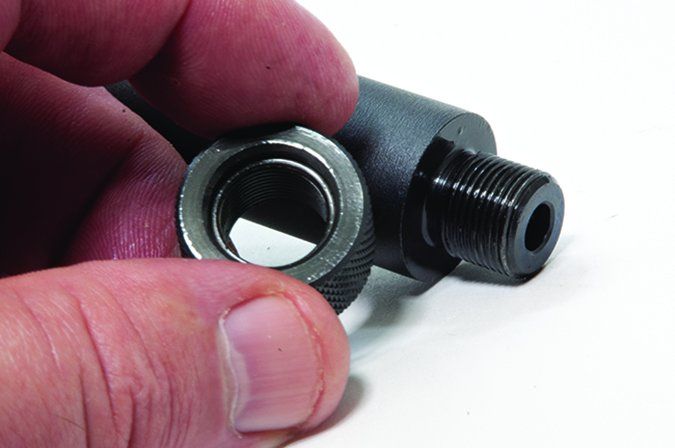
The bolt-action rifle had a black synthetic stock with a sporter forend, which rolled on the bags a little. The straight comb was comfortable, and the 13.5-inch length of pull was just a little short for our shooters. There was a sling-swivel stud in the forend to attach a bipod or sling. The shape of the stock worked for both right-handed and lefty shooters. This version didn’t include the AccuStock bedding system, but the barrel free-floats in the barrel channel. It has checkered panels on the wrist and forend. At the range, we noticed the pitch of the stock and low comb caused the shooter’s face to sit above the stock. Also, we noticed a faint mold line on top of the stock, which we would trim with an X-Acto knife if we shot other positions with it.
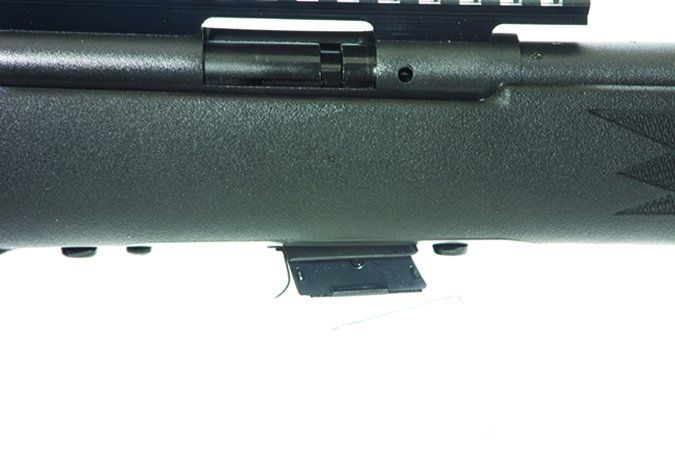
All three had adjustable triggers, which we were glad to see. To adjust the AccuTrigger in the Mark II, make sure the firearm is unloaded and the bolt is open before removing the stock and adjusting the trigger. We were happy with the pull at 2.4 pounds as delivered, and we dropped the rifle on its butt and sides to ensure that the sear didn’t release with the safety in the Fire position. That pull weight was much better than the Ruger at 3.6 pounds as it came out of the box, but which we adjusted down to 3.0 pounds. Same for the CZ at 3.1 pounds out of the box, but which we tinkered down to 3.0 pounds.
Though we didn’t adjust the Savage’s trigger, it’s worth noting how to do it. Remove the stock and insert the AccuTrigger supplied tool into the bottom of the trigger return spring to engage the spring-tail with the slot on the tool. Turn the trigger return spring with the trigger adjustment tool. To adjust for a heavier pull, turn the tool clockwise. The maximum trigger pull is at the point where the spring clicks when rotated. Turning the tool counter-clockwise gets a minimum trigger pull. This occurs when the large coil contacts the top surface of the trigger and provides resistance the user can feel.
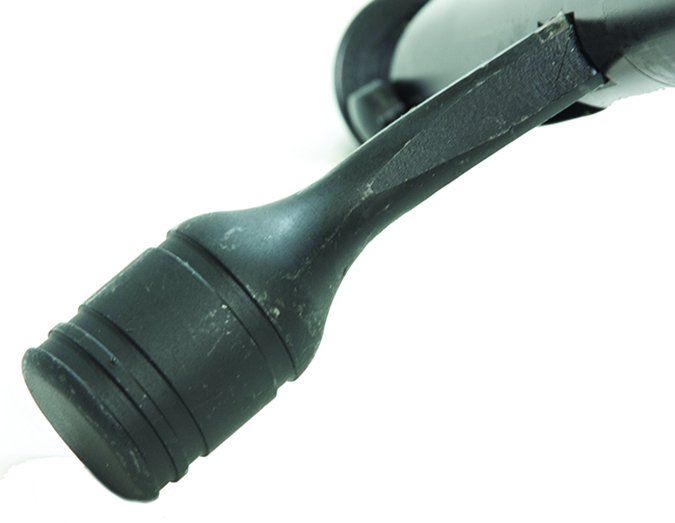
Operationally, the Savage was very well mannered. Installing a riflescope was easy because it came fitted with a 1913 rail, a plus over the grooves on the Ruger and CZ. We had no issues installing or removing the SilencerCo suppressor on the threaded barrel. The thread protector was easy to remove and install. We liked the big bolt handle better than the others because it provided a lot of grasping surface opening and closing the action. We had no misfeeds out of the supplied 5-round magazine, which was easy to seat. We otherwise had no failures to fire or extract, and ejected brass shot close or far depending on how hard we worked the bolt. There was a thin plastic buttpad on the Savage. We’d like to see a thin rubber buttpad to create more stick on the shoulder, but some will argue that’s exactly what they don’t want.
The safety on the Savage Mark II FV-SR has two positions. The Safe position has the safety button fully rearward toward the shooter and the red dot on the right rear of the receiver covered. This blocks the trigger but does not prevent the bolt from being opened. The Fire position has the safety button pushed toward the target, exposing the red dot on the action. Everything worked perfectly, except for one mishap. During one string, we were working the bolt actively, and suddenly the gun wouldn’t fire. We had accidentally knocked the safety forward.
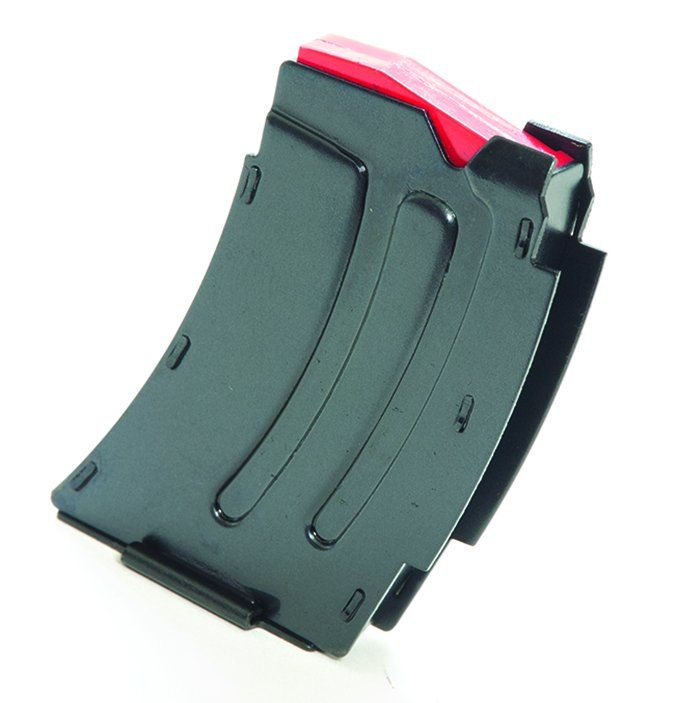
When kneeling and standing, we could run the 60-degree bolt throw comfortably without having to take our cheek off the stock. The big bolt handle aided this process as well. However, in these other positions, the high scope position atop the rail and rings made us cheek-weld the gun to the side of the jawbone. It wasn’t uncomfortable, but it did feel different on the other rifles.
Prior to installing the bolt, the shooter ensures there is no ammunition in the chamber. Then we rotated the front baffle to line-up the bolt guide with the extractor, pulled the trigger fully rearward and held it in that position, then inserted the bolt into the firearm, pushing it forward. To remove the bolt, which we did a lot to ensure the gun couldn’t be fired when we installed the suppressor, with an empty gun and the muzzle pointed in a safe direction, we moved the safety forward to Fire, lifted the bolt handle and pulled the bolt fully to the rear, opening the action, then pulled the trigger fully rearward and held it in that position. When the bolt seemed to bind or stop, it usually meant we had lost engagement on the trigger. Savage noted the presence of a cocking indicator on the back end of the bolt, the purpose of which is to visually show when the firearm is cocked. This is not a loaded-chamber indicator. When cocked, the hat-shaped part of the indicator protrudes from the rear of the bolt about a quarter inch. Once a shot is fired, the indicator moves forward.
Our Team Said: It was the most accurate gun in the test. We liked the feel of the magazine fit and lock, and the steel body of the magazine seemed bulletproof and was rigid and resisted flexing. We liked the bolt handle, and the AccuTrigger was excellent. It has a short overall length, which makes it suitable for use with a silencer. With the right ammo, we can see shooting this out to 200 or 300 yards, which would likely require replacing the rail with a 25-MOA rail. We checked the buyer reviews at Bud’s, and this rifle got a 4.5 out of 5 stars. We’d have to agree that this is an excellent rimfire for the money.
Ruger American Rimfire Standard 8305 22 LR, $309
GUN TESTS GRADE: B+
This is a well-thought-out rifle with a lot of flexibility. We liked its cheekweld best because of the high comb module. It was the least accurate gun in the test, but only by small margins. If you already own a 10/22 and have magazines on hand, this might jump to being your top choice with no argument from us.

| ACTION | Bolt; steel cylindrical receiver |
| OVERALL LENGTH | 34.5 in. |
| HEIGHT UNBOXED | 7 in. |
| HEIGHT AS TESTED | 9.6 in. |
| MAX WIDTH | 25 in. |
| WEIGHT UNBOXED | 5.9 lbs. |
| WEIGHT AT RANGE | 7 lbs. |
| BARREL LENGTH/TWIST | 16.5 in.; 1:16 RH |
| BARREL FINISH/MATERIAL | Matte-blue carbon steel; cold hammer forged |
| BARREL FREE-FLOATED | Yes |
| BARREL MUZZLE DIAMETER | 0.613 in. |
| MUZZLE STYLE/DEVICE | 1/2″-28 thread; checkered steel thread protector |
| STOCK | Black synthetic; soft touch finish |
| STOCK LENGTH OF PULL | 13.75 in. |
| STOCK COMB STYLE | Straight |
| DROP AT COMB | 1.1 in. |
| DROP AT HEEL | 1.25 in. |
| STOCK CAST | None |
| STOCK HANDEDNESS | Ambidextrous |
| FOREND STYLE | Sporter; plain |
| BUTTPAD THICKNESS | 0.3 in.; contoured black plastic |
| SLING SWIVEL STUDS | 1 butt, 1 forend |
| STOCK GRIP CAP | Black plastic |
| TRIGGER PULL WEIGHT | 3.1 lbs.; adjustable |
| TRIGGER STYLE | Single stage |
| TRIGGER GUARD MATERIAL | Matte-black steel |
| SAFETY | 2-position bolt-mounted lever |
| MAGAZINE | (1) 5-rd. single stack |
| MAGAZINE RELEASE | Plastic tab; front of magwell |
| BOLT | Stainless steel; two extractors; 60-degree throw, integral hollow ball handle |
| BOLT RELEASE | Trigger |
| SIGHTS | None |
| OPTICS MOUNTING HARDWARE | 11mm receiver dovetail |
| WARRANTY | 5-year limited |
| TELEPHONE | (800) 955-4486 |
| WEBSITE | CZ-USA.com |
| MADE IN | Czech Republic |
The 8305 came with two interchangeable standard length-of-pull stock modules that provide comb height options for scope or iron sight use. We knew immediately that we wanted the taller comb, so we simply screwed out the rear sling swivel stud, pulled off the standard-height stock module, and slipped on the taller one. It took about three minutes, in part because we had a little trouble fitting the second module into the stock cavity. Once the taller module was on, we noticed no wiggle or movement in the unit. If the gun is destined for a younger shooter, compact stock modules are available at ShopRuger.com.
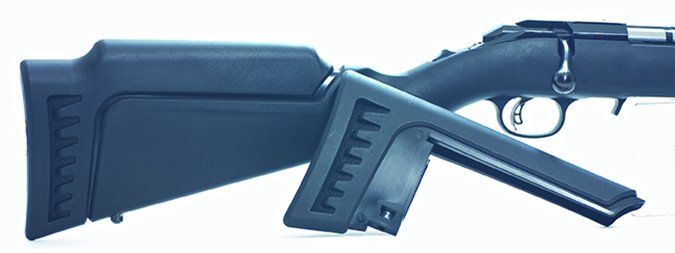
The Ruger came with one detachable, flush-mounted 10/22 BX-1 10-round rotary magazine, but the rifle will accept all 10/22 magazines, including the BX-25, BX-25×2 and BX-15. A 10/22-style extended magazine release provides removal of the flush-mounted magazine. We were able to simply push the lever firmly and the mag would drop out. Under the action is a Power Bedding integral bedding block system. The rifle’s hammer-forged barrel is mated to the steel action, and this barreled action sits on a pair of V-notch supports that bed the action. This free-floats the barrel and is said to provide accuracy. Holes in paper determined that that was mostly true, but the Savage did a lot better with the Eley.
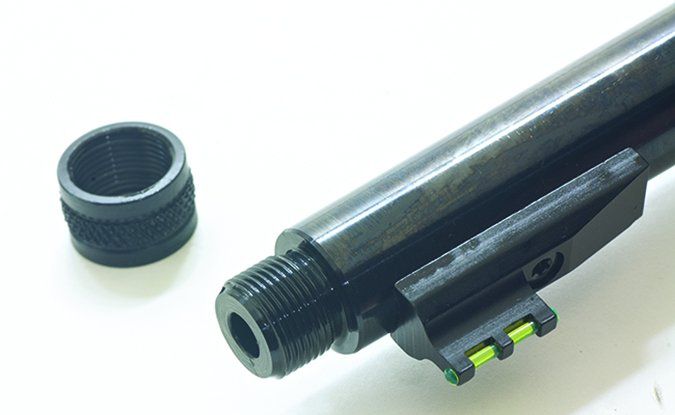
The Ruger Marksman Adjustable trigger is a great touch in a rimfire. It is a single stage, but in some respects it feels like a two-stage trigger. On the bench, the shooter’s trigger finger contacts the blade in the trigger shoe and engages the trigger mechanics. In a two-stage, the first stage actually takes some of the draw weight, so the second-stage release requires a minimal amount of pressure to release the sear. The Marksman trigger allows the shooter to start the trigger press as the crosshairs come onto the target, then break the shot when it’s centered up. Draw weight isn’t reduced as the trigger finger pulls the blade into the shoe, but the timing feels somewhat the same. We found ourselves working the trigger in and out as the hold settled in the X-ring or drifted out. Also, the pull is user adjustable between 3 and 5 pounds. Ours came set at 3.6 pounds with a repeatable break point, so we could have left it as it came out of the box. But since the ability was there, we went ahead and dialed it down to 3.0 pounds.
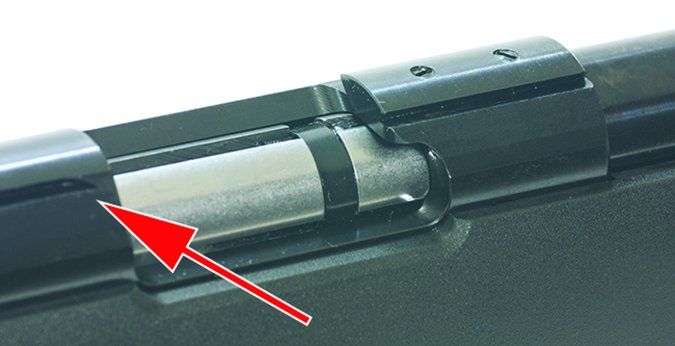
To access the pull-weight set screw, remove the barreled action from the stock. The set screw is located on the outside, forward edge of the fire control housing and is treated with a thread-locking compound, so it was difficult to move. Turning the screw in (clockwise) will increase the trigger pull weight; threading the screw out (counter-clockwise) will reduce the trigger pull weight. There is about six full turns of adjustment. Turning the screw in no more than half-revolution increments, we got the trigger-pull weight down to 3 pounds.
The lightweight black synthetic stock has a rakish look, with forend contouring and grip serrations. The slider tang safety is positive and sure, and it doesn’t offer an opportunity to accidentally move it when working the bolt. A 3⁄8-inch rimfire scope groove is machined into the receiver, which is also drilled and tapped for Weaver #12 bases (not included). All told, we preferred having a Picatinny rail already mounted, as on the Savage, and we preferred the CZ-USA’s open-ended 11mm dovetail groove rather than the Ruger’s discontinuous set of rear grooves.
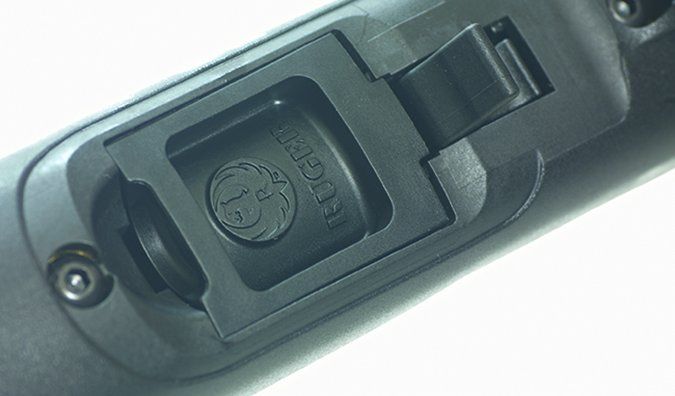
We enjoyed working the Ruger’s 60-degree bolt. The shooter could ride the crosshairs through recoil and quickly chamber another round without having to readjust head position. The bolt knob had ample scope clearance, which wasn’t an issue with our tall rings, and we really liked the receiver-mounted bolt removal-release, which allows the bolt to be readily extracted out the rear of the action without requiring a pull of the trigger. Ruger claims this is a “unique safety feature among rimfire, bolt-action rifles,” and perhaps it is a one-of-a-kind treatment. We don’t know that for sure, but we do know we prefer the Ruger’s bolt release over the CZ and Savage mechanisms, which require pulling the triggers to let the bolt slip out and to pull the trigger to slide the bolts back in.
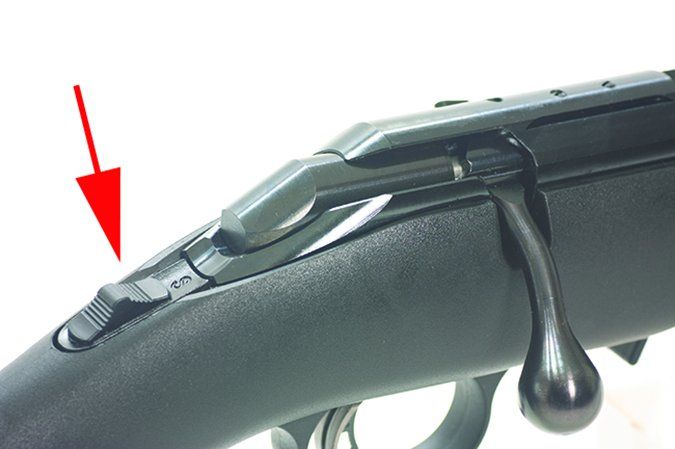
The Ruger has a two-position tang safety. The safety selector is located behind the bolt sleeve. The safety selector can be moved from the Fire position to the Safe position only when the firing pin is cocked. Fully raising the bolt handle cocks the firing pin. The cocking piece will protrude from the bolt shroud when the firing pin is cocked. We liked this safety better than the Savage’s and as well as the CZ’s lever. It was visible, accessible, and easy to operate.
On top of the Ruger are a Williams fiber-optic front sight and adjustable V-slot folding-leaf rear sight, a feature the others lacked. Out front, the bolt-action rifle featured a 1⁄2×28-threaded barrel with a thread protector and a matte-blued finish. Like the others, the Ruger has 1:16-inch right-hand rifling.
This rifle’s dimensions are in range of the others. Out of the box, it weighed 5.5 pounds, and loaded out at the range, the Ruger weighed a tenth of a pound more than the CZ and about a tenth less than the Savage. Overall length was a handy 37 inches, with a 13.75-inch length of pull, which we liked better than the Savage. After handling and testing the Ruger, our shooters said that it was easy to manipulate in and out of vehicles.
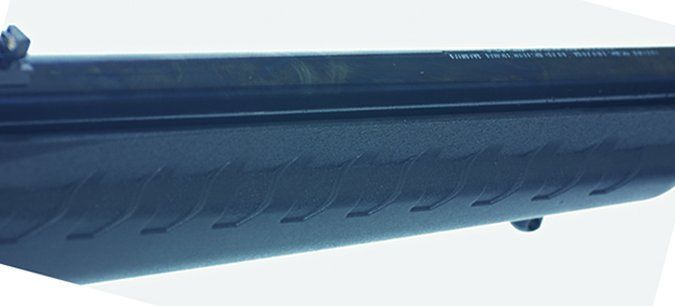
Like on the others, we couldn’t see any cast in the stock, and both left- and right-handed shooters could shoulder the rifle comfortably. The stock was a thin sporter shape like on the others, which made it roll around on the bags. It just took a little patience to get the bags to support the rifle in the 10-ring.
The stock had two sling-swivel studs, one in the butt and one in the forend. There was no buttpad or buttplate per se, but the stock module had an area on it that was buttpad-ish, with serrations in the composite comb module. Like with the other rimfires, recoil wasn’t an issue. But we’d prefer something just a little more tacky on the butt. The pistol grip had a grooved texture molded into it.
The 10-shot magazine loaded easily, and the cartridges fed smoothly. Only one rotary magazine came with the rifle. It fits flush with the bottom of the stock, reducing the chance of it hanging on clothing or car parts and making that area easier to handle than having the magazines stick out as on the CZ and Savage. All ammunition tested functioned perfectly.
Our Team Said: The Ruger is a fine firearm, but in this test it is squeezed from the bottom and the top by the Savage and the CZ. It would be our third pick, but that wouldn’t be so bad.
CZ-USA 455 American Synthetic Suppressor-Ready 02114 22 LR, $373
GUN TESTS GRADE: B+
Clean lines and the best shooter with the suppressor on. Would have liked a slightly higher comb or less pitch in the stock. This is the most expensive gun in the test, and perhaps it will speak to you. Its barrel-change ability might break the tie for some.

| ACTION | Bolt; hexagonal receiver |
| OVERALL LENGTH | 37 in. |
| HEIGHT UNBOXED | 7 in. |
| HEIGHT AS TESTED | 9.6 in. |
| MAX WIDTH | 2.8 in. |
| WEIGHT UNBOXED | 5.5 lbs. |
| WEIGHT AT RANGE | 7.1 lbs. |
| BARREL LENGTH/TWIST | 18; 1:16 RH; 6 grooves |
| BARREL FINISH/MATERIAL | Satin blued alloy steel; cold hammer forged |
| BARREL FREE-FLOATED | Yes |
| BARREL MUZZLE DIAMETER | 0.635 in. |
| MUZZLE STYLE/DEVICE | 1/2″-28 thread; knurled thread protector |
| STOCK | Black composite; 2 cheekpieces; grip serrations Power Bedding system |
| STOCK LENGTH OF PULL | 13.75 in. |
| STOCK COMB STYLE | Straight |
| DROP AT COMB | 1.1 in. |
| DROP AT HEEL | 2.1 in. |
| STOCK CAST | None |
| STOCK HANDEDNESS | Ambidextrous |
| FOREND STYLE | Sporter; serrations |
| BUTTPAD THICKNESS | None |
| SLING SWIVEL STUDS | 1 butt, 1 forend |
| STOCK GRIP CAP | Black plastic; Ruger logo |
| TRIGGER PULL WEIGHT | 3.6 lbs.; Marksmen adjustable |
| TRIGGER STYLE | Single stage |
| TRIGGER GUARD MATERIAL | Black composite, integral |
| SAFETY | 2-position tang-mounted slider button |
| MAGAZINE | (1) 10-rd. 10/22 BX-1; rotary flush-fit black polymer |
| MAGAZINE RELEASE | 10/22-style extended |
| BOLT | Stainless steel; two extractors, 60-degree throw, blued ball handle |
| BOLT RELEASE | Receiver-mounted lever |
| SIGHTS | Front: Williams green fiber optic; Rear: adjustable folding leaf |
| OPTICS MOUNTING HARDWARE | 3/8″ receiver grooves; drilled & tapped for Weaver #12 |
| WARRANTY | None written |
| TELEPHONE | (336) 949-5200 |
| WEBSITE | Ruger.com |
| MADE IN | Mayodan, NC |
The CZ 455 is the latest generation of the CZ bolt-action rimfire, and it has steadily replaced the 452 line as CZ consolidates all of the receivers onto one common platform. This, combined with the new interchangeable barrel system of the CZ 455, allows the user to easily change the stock configuration as well as the caliber of the rifle.
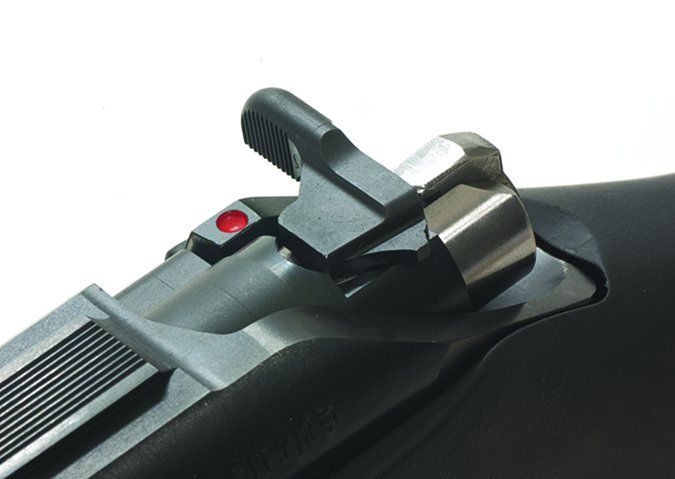
We’ve become more interested in the 455s because of this flexibility. When the shooter removes two action screws, he can take off the stock and loosen two set screws that retain the barrel. Then, if desired, on goes another tube, such as in 17 HMR. Headspace is not an issue because the barrels are pre-fit and drop-in. We can see using our existing rifle and adding the extra barrel and forming our own Combo unit.
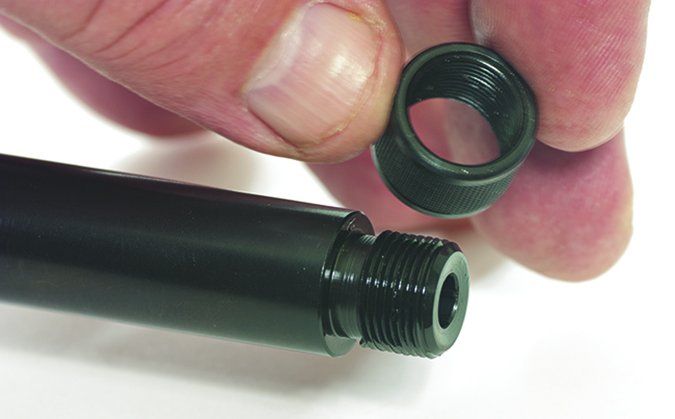
The 455 also has an adjustable trigger, which can be tuned by taking the barreled action out of the stock, a hammer-forged barrel, and billet-machined receiver. Improvements the company says the 455 brings include new manufacturing technology and tighter tolerances for improved accuracy and smoother operation.
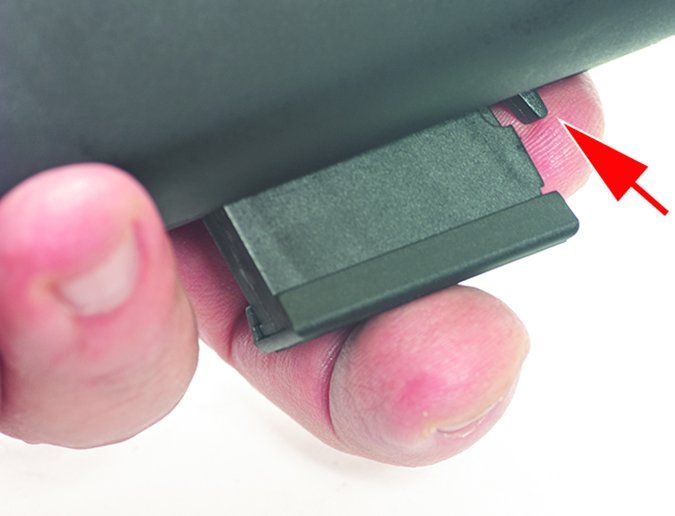
On our test CZ 455 02114, we liked the synthetic stock, which meant not having to worry about banging up a pretty wood one on the wood-stocked versions. Its black synthetic stock has a soft-touch finish and is in the American style with a high, flat comb intended for use with a scope. We preferred the even-higher Ruger comb because we could apply some pressure with the cheek. The CZ stock was just low enough so we could touch the stock with the cheek, but we couldn’t settle on it as we did with the higher Ruger module.
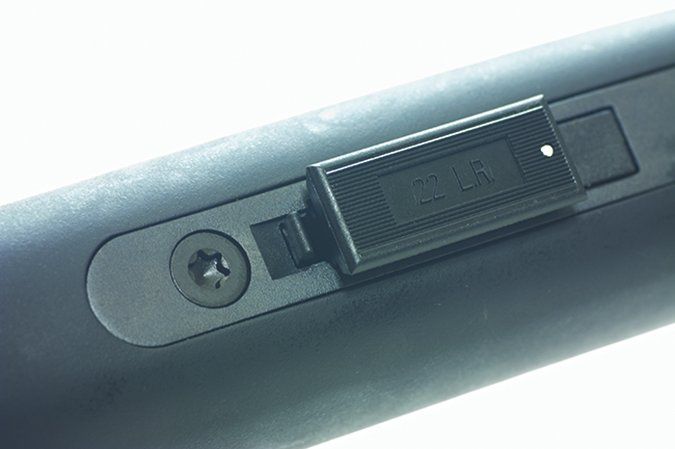
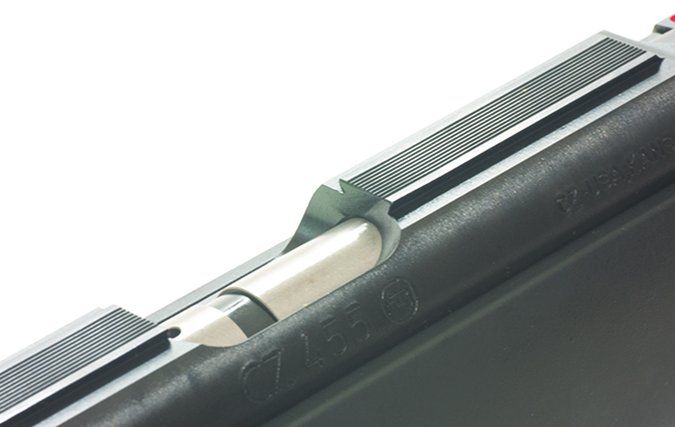
Our test rifle had a 16.5-inch barrel that comes from the factory with 1⁄2×28 threads. The SilencerCo Osprey went on and off the CZ easily and without incident. It tied for producing the smallest average groups in the test, 0.5 inches with the Eley, and, overall, it shot the best suppressed, bringing in groups below an inch with all three ammunition brands.
Our Team Said: The CZ-USA 455 is a very well mannered, stable, easy-to-shoot rifle. It costs quite a bit more than the Savage, so you’ll have to decide if it’s worth it.
Written and photographed by Gun Tests staff, using evaluations from Gun Tests team testers.
































You have the data block for the CZ455 mixed with the Ruger American…